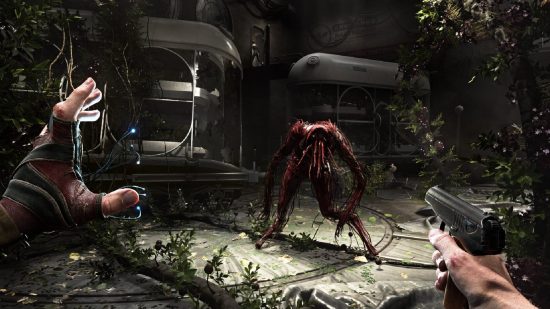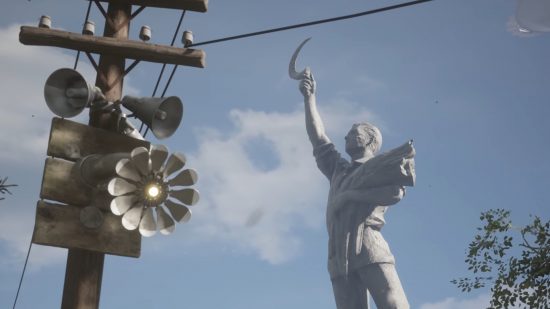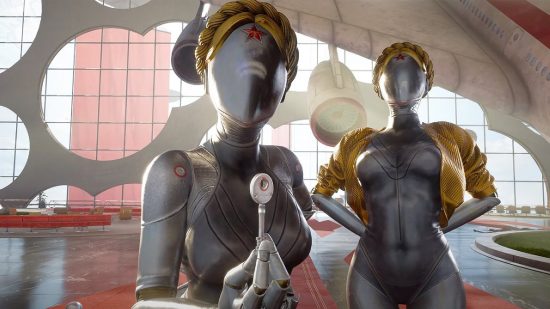Our Verdict
Behind all of the beauty, Atomic Heart is a poor imitation of other triple-A games. Terrible dialogue, clunky gameplay, and an unnecessary open world makes for a heartless experience.
Atomic Heart has been on my wishlist for years. Ever since I randomly came across it on YouTube, it’s been a game that has piqued my interest. As more trailers and reveals dropped, my excitement only built up, but that did also come with a level of scepticism. Now that it’s in my hands, I’m feeling massively disappointed with what I’ve considered my most anticipated title in recent memory.
In Atomic Heart, you play as a private agent called P-3, armed with a powerful glove called CHAR-les, or Charles. This all takes place in an alternate universe version of the Soviet Union in the 1950s, with Russia being ahead in scientific and robotic studies. You’re ordered to go to Facility 3826 by Professor Sechenov, one of the most brilliant minds in the USSR and head of the new neural network Kollektiv.
However, things go awry when you find that someone has activated a combat mode in all of the robots in the facility. Armed with whatever P-3 can find, and whatever polymers Charles can be upgraded with, you’re set out to investigate what has happened in Facility 3826, following a trail of mysteries and conspiracies, all while taking down hundreds of corrupted and vicious robots.

Atomic Heart’s narrative is fairly simple in nature, borrowing a lot from other iconic pop culture stories like Terminator, or even films like iRobot, but it does enough here to populate its own lore and story. There are audio logs to hear and computer files to read through the facility, all of which offer interesting perspectives into the world of this alternate USSR. There were concerns before launch that Atomic Heart may look to push pro-Russian messaging due to its setting, but a lot of the sentiment I’ve seen actually comes across the opposite.
The version of this USSR follows a similar pattern to the version in our world. Despite hoping for a successful communist society, there are still people at the top of the food chain, who lie and cheat their way to success. While this alternate take does show the country to be advanced beyond even our own technology, it’s unravelling at the seams. While we won’t be spoiling the plot of the game here, the narrative does show that things in this universe go equally wrong, despite a prosperous USSR we witness in the game.
However, the pacing of the game itself ruins whatever interest I had in the narrative from the get-go. Whenever you’re making your way through the main story, tedious obstacles pop up in the way. Whether you’re looking for canisters in different labs or finding robot limbs in various rooms, it feels dragged out and boring, with lots of padding out to extend the total Atomic Heart length. As soon as some element of the game started to entice me and get me excited for what is coming up, I was told to complete some annoying chore, such as picking up four different canisters in various labs, or finding different robot limbs, just to access the next area.

Thankfully, there is some combat and gameplay to experience during these times. P-3 is armed with an arsenal of weapons and abilities. Unfortunately, the core gameplay loop is frustrating. Most of it boils down to shooting a gun that has no weight to it, dodging awkwardly out of the way, getting stuck in corners or on random objects, and getting mercilessly hit until you break away from the horde and start shooting again. Any tension is lost to mechanics that feel awkward to use and offer no exciting feedback to me.
This is felt right the way through the game’s arsenal. While the abilities can be fun to use occasionally, they are very, very basic in what they offer. Most of the time, I used Frostbite, which freezes any enemies unfortunate enough to approach me. I can’t lie and say it didn’t make things pretty easy, but with how clunky the combat and gameplay can feel, I was just happy to have something that made it quicker to get through engagements.
While I often opted to speedrun most of my encounters with any enemies to simply get through the game, I do think the enemy design is well suited to Atomic Heart’s aesthetic. . From moustached robots to weird Polymer creatures, the enemy design can be simultaneously alluring and terrifying. The problem though, is that they’re never balanced in numbers, and whenever they pop out of corridors with their unchanging faces, they’re often overwhelming.
Many of the enemies can be found during the more linear portions of the game, but there is an open world which is fairly large, yet completely empty and devoid of any cohesion. It feels tacked on, a way to add another tag to the game in the hopes of a sale. Driving vehicles, while not often, feels floaty and flat-out boring, and a lack of any interesting world building features makes it feel tired and dated. There are some puzzles scattered across the Atomic Heart map, but these are extremely basic and almost pointless.
Speaking of the world, it’s also filled with vulgar and sexual encounters that feel forced and awkward. A vending machine, which picks you up with its wires, whispers disgusting things to you as you’re picked up off the floor, and the robot twins, which have been the subject of many NSFW posts both before and after launch, feel like they’re there only for you to gawk at.

As such, Atomic Heart feels uncomfortably and unnecessarily oversexualised, making light of serious topics in the process. These characters – and their jokes – serve little to no purpose and the game would be better without them.
Performance-wise, Atomic Heart suffers with plenty of issues and bugs that made my experience on the PS5 frustrating. Cutscenes regularly dropped frames, offering a jarring experience overall. Enemy animations also feel off in places and the hit detection feels bad enough to be noticeable.
While performance issues can ruin any experience for the best of games, Atomic Heart’s biggest crime is the fact that nothing feels unique. So many elements are clearly taken from other games, and not very well. You’ve got Dying Light’s climbing, Resident Evil’s inventory, a forced open world that we’ve seen stuffed into plenty of recent triple-A titles for no benefit – it’s all here. Outside of its interesting aesthetic, everything else about Atomic Heart feels very generic.
As the credits roll on Atomic Heart, all I feel is incredibly underwhelmed about my experience. A game I had spent months thinking about and waiting for felt nothing more than a blend of games I’ve already played, but worse. Its graphics are a highlight, especially for a small team of developers, but everything else makes Atomic Heart a slog to complete.
Developer Mundfish has come under increasing scrutiny in recent weeks after it was alleged that the Russian government stands to gain financially from the release of Atomic Heart. This is due to the fact that investors involved in the financing of Mundfish include GEM Capital, an investment fund whose founder has ties to Gazprom and VTB Bank, both of which are majority-owned by the Russian state.
Mundfish is also partnering with VK (formerly Mail.RU) for the Russian release of Atomic Heart, evading sanctions on Steam – VK is also majority-owned by the Russian state through Gazprombank, and Mundfish’s CEO is a former Creative Director at Mail.RU.
With Russia’s ongoing invasion of Ukraine, many players are now choosing to boycott the game in protest and donate money to organisations like The Ukraine Crisis Appeal, International Rescue Committee, and the British Red Cross.
